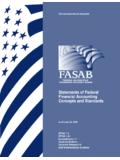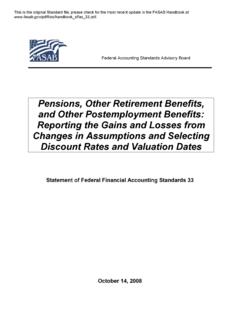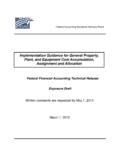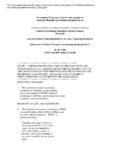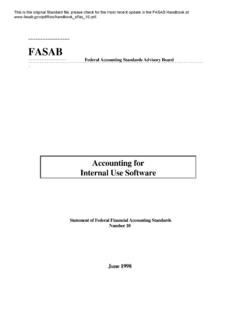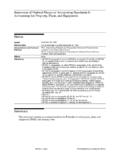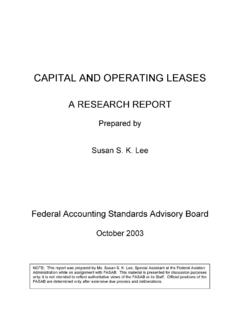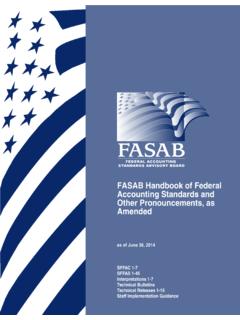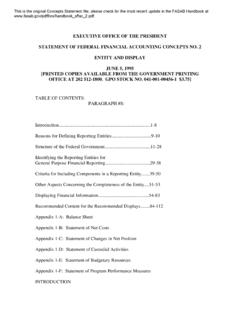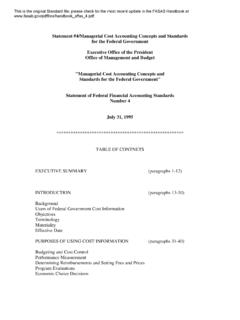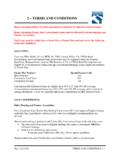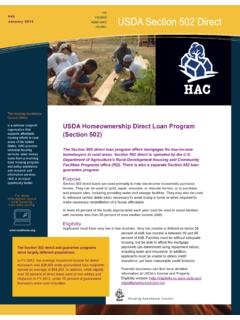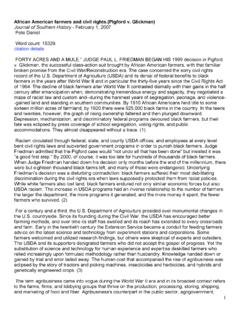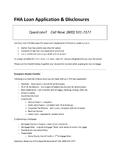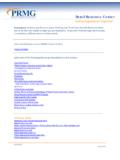Transcription of Accounting for liabilities SFFAS No. 5 Office of ...
1 Accounting for liabilitiesSFFAS No. 5**Executive Office of the PresidentOffice of Management and Budget" Accounting FOR liabilities OF THE FEDERALGOVERNMENT"Statement of Federal Financial Accounting StandardsNumber 5 September 1995**This is the original Standard file; please check for the most recent update in the FASAB Handbook at **From Inside Front Cover**APPLICABILITY, MATERIALITY, AND TERMINOLOGYT hese standards apply to general purpose financialreports of Government reporting standards need not be applied to immaterialitems. Statement of Federal Financial AccountingConcepts No. 2 (SFFAC No. 2), "Entity andDisplay", lists criteria for defining Governmentreporting entities. Paragraph 78 of "Entity andDisplay" notes that some of a reporting entity'scomponents may be required by law or policy toissue financial statements in accordance withaccounting standards other than those recommendedby the FASAB and issued by the OMB and the GAO, , Accounting standards issued by the FinancialAccounting Standards Board or by a regulatoryagency.
2 Those components should continue to applythe standards used in these reports. The reportingentities of which the components are a part,however, need to be sensitive to differences thatmay arise from different Accounting standards. Ifthese differences are material, the standardsrecommended by the FASAB and issued by the OMB andthe GAO should be applied. In such cases, thecomponents would need to provide any additionaldisclosures or different measurements required bythe Accounting standards issued by the OMB and theGAO that would not be required by the word "disclosure" in FASAB's recommendedstandards indicates reporting information in notesor narrative that is regarded as an integral partof the basic financial statements, while"supplemental" indicates reporting information inschedules or narrative regarded as "requiredThis is the original Standard file; please check for the most recent update in the FASAB Handbook at supplementary information" as that term is used inaccounting and auditing standards.
3 Governmentauditing standards require little auditingassurance for required supplementary information."Other accompanying information" refers tounaudited information that accompanies the auditedfinancial statements. "Required supplementarystewardship information" is a new category ofinformation FASAB proposes in its exposure draft,"Supplementary Stewardship Reporting", with theexpectation that OMB and GAO will in collaborationagree upon audit procedures that would beappropriate to apply to this information. Theseterms are intended to indicate the Board'sexpectations regarding the minimum auditor'sresponsibility for the information, not itsspecific location within general purpose financialreports.**EXECUTIVE SUMMARY**a This Statement establishes accountingstandards for liabilities of the federalgovernment not covered in Statement of FederalFinancial Accounting Standards Number 1," Accounting for Selected Assets and liabilities ",and in Statement of Federal Financial AccountingStandards Number 2, " Accounting for Direct Loansand Loan Guarantees.
4 " This Statement defines"liability" as a probable future outflow or othersacrifice of resources as a result of pasttransactions or events. [FN 1:Liabilitiesrecognized according to the standards in thisStatement include both liabilities covered bybudgetary resources and liabilities not covered bybudgetary resources. liabilities covered bybudgetary resources are liabilities incurred thatwill be covered by available budgetary resourcesencompassing not only new budget authority butalso other resources available to coverliabilities for specified purposes in a givenyear. liabilities not covered by budgetaryresources include liabilities incurred for whichrevenues or other sources of funds necessary toThis is the original Standard file; please check for the most recent update in the FASAB Handbook at pay the liabilities have not been made availablethrough congressional appropriations or currentearnings of the reporting entity.]
5 Notwithstandingan expectation that the appropriations will bemade, whether they in fact will be made iscompletely at the discretion of the Congress.(Adapted from OMB Bulletin No. 94-01, "Form andContent of Agency Financial Statements.")]b The Statements of Federal FinancialAccounting Standards ( SFFAS ) and Concepts (SFFAC)referred to in this document are statementsrecommended by the Federal Accounting StandardsAdvisory Board (FASAB), approved by the Secretaryof the Treasury, the Director of the Office ofManagement and Budget, and the Comptroller General(the Principals) and issued by the Office ofManagement and Budget (OMB) and the GeneralAccounting Office (GAO).c This Statement defines the recognition pointsfor liabilities associated with different types ofevents and transactions (**Figure 1 IS AVAILABLEIN HARD COPY ONLY**).[FN 2: Recognition meansreporting a dollar amount on the face of the basicfinancial statements.
6 ]-- A liability arising from reciprocal or"exchange" transactions ( , transactions inwhich each party to the transaction sacrificesvalue and receives value in return) should berecognized when one party receives goods orservices in return for a promise to provide moneyor other resources in the future ( , a federalemployee performs services in exchange forcompensation).-- A liability arising from nonreciprocaltransfers or "nonexchange" transactions ( ,transactions in which one party to the transactionreceives value without directly giving orpromising value in return, such as grant andcertain entitlement programs) should berecognized for any unpaid amounts due as of thereporting date. The liability includes amountsdue from the federal entity to pay for benefits,This is the original Standard file; please check for the most recent update in the FASAB Handbook at goods, or services [FN 3: Goods or services may beprovided under the terms of the program in theform of, for example, contractors providing aservice for the government on the behalf of thedisaster relief beneficiaries.
7 ] provided under theterms of the program, as of the federal entity'sreporting date, whether or not such amounts havebeen reported to the federal entity ( ,estimated Medicaid payments due to healthproviders for service that has been rendered andthat will be financed by the federal entity buthave not yet been reported to the federal entity).-- Government-related events are nontransaction-based events that involve interaction betweenfederal entities and their environment. The eventmay be beyond the control of the entity. Aliability is recognized for a future outflow ofresources that results from a government-relatedevent when the event occurs if the future outflowof resources is probable and measurable (seeparagraphs 33 and 34 for the definitions ofprobable and measurable, respectively) or as soonthereafter as it becomes probable and , such as a federal entity accidentallycausing damage to private property, would create aliability when the event occurred, to the extentthat existing law and policy made it probable thatthe federal government would pay for the damageand to the extent that the amount of the paymentcould be estimated reliably.
8 Government-relatedevents also include hazardous waste spills onfederal property caused by federal operations oraccidents and catastrophes that affect government-owned events are events thatare of financial consequence to the federalgovernment because it chooses to respond to theevent. A liability is recognized for a futureoutflow of resources that results from agovernment-acknowledged event when and to theextent that the federal government formallyacknowledges financial responsibility for theevent and a nonexchange or exchange transactionhas occurred. The liability for a nonexchangeThis is the original Standard file; please check for the most recent update in the FASAB Handbook at transaction should be recognized for any unpaidamounts due as of the reporting date and theliability for the an exchange transaction shouldbe recognized when goods or services have beenprovided.
9 The liability includes amounts due fromthe federal entity to pay for benefits, goods, orservices provided under the terms of the program,as of the federal entity's reporting date, whetheror not such amounts have been reported to thefederal entity (Examples of government-acknowledged events include toxic waste damagecaused by nonfederal entities and damage fromnatural disasters).d In addition to discussing the generalliability recognition principle, the Statementincludes several specific federal liabilityaccounting standards which are summarized Contingencies - A contingency is an existingcondition, situation, or set of circumstancesinvolving uncertainty as to possible gain or lossto an entity that will ultimately be resolved whenone or more future events occur or fail to future outflows or other sacrifices ofresources as a result of past transactions orevents may be recognized, may be disclosed [FN 4:"Disclosure" in this document refers to reportinginformation in notes regarded as an integral partof the basic financial statements.]
10 ], or may not bereported at all, depending on thecircumstances.[FN 5: In the case of government-acknowledged events giving rise to nonexchange orexchange transactions, there must be a formalacceptance of financial responsibility by thefederal government, as when the Congress hasappropriated or authorized ( , throughauthorization legislation) , exchange transactions that arisefrom government-acknowledged events would berecognized as a liability when goods or servicesare provided. For nonexchange transactions, aliability would then be recognized at the pointthe unpaid amount is due. Therefore, government-acknowledged events do not meet the criterianecessary to be recognized as a contingentThis is the original Standard file; please check for the most recent update in the FASAB Handbook at liability.] Contingencies should be recognized asa liability when a past transaction or event hasoccurred, a future outflow or other sacrifice ofresources is probable, and the related futureoutflow or sacrifice of resources is contingent liability should be disclosed if anyof the conditions for liability recognition arenot met and there is a reasonable possibility thata loss or an additional loss may have beenincurred.
